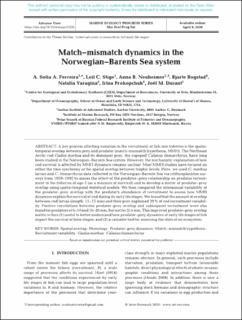| dc.contributor.author | Ferreira, Ana Sofia De Araújo | |
| dc.contributor.author | Stige, Leif Christian | |
| dc.contributor.author | Neuheimer, Anna B. | |
| dc.contributor.author | Bogstad, Bjarte | |
| dc.contributor.author | Yaragina, Natalia A. | |
| dc.contributor.author | Prokopchuk, Irina | |
| dc.contributor.author | Durant, Joel Marcel | |
| dc.date.accessioned | 2020-10-21T14:01:50Z | |
| dc.date.available | 2020-10-21T14:01:50Z | |
| dc.date.created | 2020-04-15T09:30:07Z | |
| dc.date.issued | 2020 | |
| dc.identifier.issn | 0171-8630 | |
| dc.identifier.uri | https://hdl.handle.net/11250/2684282 | |
| dc.description.abstract | A key process affecting variation in the recruitment of fish into fisheries is the spatio-temporal overlap between prey and predator (match-mismatch hypothesis, MMH). The Northeast Arctic cod Gadus morhua and its dominant prey, the copepod Calanus finmarchicus, have long been studied in the Norwegian-Barents Sea system. However, the mechanistic explanation of how cod survival is affected by MMH dynamics remains unclear. Most MMH studies have focused on either the time synchrony or the spatial overlap between trophic levels. Here, we used G. morhua larvae and C. finmarchicus data collected in the Norwegian-Barents Sea via ichthyoplankton surveys from 1959-1992 to assess the effect of the predator-prey relationship on predator recruitment to the fisheries at age 3 (as a measure of survival) and to develop a metric of predator-prey overlap using spatio-temporal statistical models. We then compared the interannual variability of the predator-prey overlap with the predator’s abundance at recruitment to assess how MMH dynamics explain the survival of cod during its early life stages. We found that the amount of overlap between cod larvae (length: 11-15 mm) and their prey explained 29% of cod recruitment variability. Positive correlations between predator-prey overlap and subsequent recruitment were also found for predators of 6-10 and 16-20 mm, but not for 21+ mm. This improved predator-prey overlap metric is thus (1) useful to better understand how predator-prey dynamics at early life stages of fish impact the survival of later stages; and (2) a valuable tool for assessing the state of an ecosystem. | |
| dc.language.iso | eng | |
| dc.title | Match-mismatch dynamics in the Norwegian-Barents Sea system | |
| dc.type | Peer reviewed | |
| dc.type | Journal article | |
| dc.description.version | acceptedVersion | |
| dc.source.journal | Marine Ecology Progress Series | |
| dc.identifier.doi | 10.3354/meps13276 | |
| dc.identifier.cristin | 1806264 | |
| dc.relation.project | Norges forskningsråd: 280468 | |
| dc.relation.project | EU/609033 | |
| dc.relation.project | EC/H2020/794301 | |
| cristin.ispublished | true | |
| cristin.fulltext | postprint | |
| cristin.qualitycode | 2 | |
